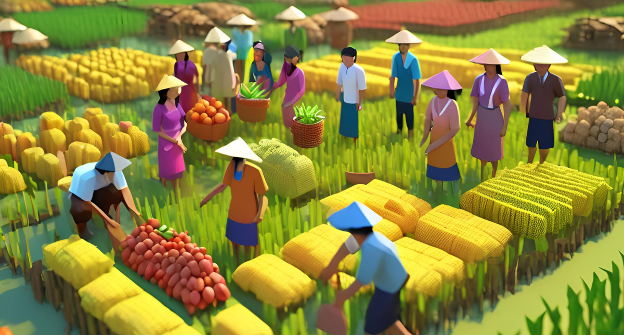Food security is fundamental to national well-being, encompassing the availability, accessibility, and utilization of nutritious food. In Malaysia, increasing self-sufficiency ratios (SSR) for essential food items has long been a government priority to reduce reliance on imports. However, focusing solely on production efficiency risks overlooking other critical aspects of food security, especially as food insecurity rises amidst global challenges like the COVID-19 pandemic.
Understanding Food Security: A Global and Malaysian Perspective
Food security refers to a state where all individuals have continuous physical, social, and economic access to sufficient, safe, and nutritious food essential for a healthy life. This concept is anchored on four main pillars: food availability, access, utilization, and stability. Conversely, food insecurity arises when there is uncertainty or limited access to adequate food, impacting well-being and economic stability.
Globally, food insecurity remains a pressing issue, with approximately 687.8 million people—or 8.9% of the global population—classified as undernourished in 2019. Vulnerable populations, especially those in low-income brackets, are disproportionately affected, often struggling to access adequate food and nutrition. This crisis underscores the need for sustained interventions to support at-risk communities and mitigate impacts on health and productivity.
In Malaysia, despite significant economic progress, food insecurity persists, particularly among the bottom 40% income group (B40). Food insecurity impacts dietary diversity and contributes to the rise of noncommunicable diseases (NCDs) like obesity, diabetes, and hypertension, which in turn drive up healthcare costs and reduce productivity.
Rice: Malaysia’s Staple Food
Rice holds a central place in Malaysian diets and is culturally significant. Each year, Malaysia consumes over 2.4 million tons of rice and rice-based products, including vermicelli and confectionery. However, local production meets only about 73% of this demand. In 2021, Malaysia produced around 2.343 million tons of paddy, which yielded approximately 1.512 million tons of rice, falling short of consumption needs. To bridge this gap, Malaysia imports rice from Thailand, Vietnam, Pakistan, and India, with imports totaling over 1.22 million tons in 2021 across varieties like basmati, fragrant rice, and Japonica.
As Malaysia’s population is expected to grow from 32.8 million in 2021 to 38.1 million by 2030, meeting the increasing demand for rice will be essential. However, trends in paddy production present challenges for food security. Data from the Department of Agriculture shows a consistent decline in production, from 2.74 million tons in 2015 to 2.43 million tons in 2021—a reduction of 11.3% over six years. If unaddressed, this decline could further compromise Malaysia’s self-sufficiency in rice.
Several factors contribute to this downward trend, including reduced cultivation areas, climate change, and limited productivity advancements. The average paddy yield dropped from 4.02 tons per hectare in 2015 to 3.75 tons per hectare in 2021. Technological adoption is limited, with many farmers in granary areas relying on outdated equipment. In 2018, the Ministry of Agriculture and Food Industry (MAFI) reported that over 86% of paddy farmers used machinery worth less than RM10,000 (US$2,222), with many renting rather than owning equipment. A 2020 MARDI study found that while 64% of farmers recognize the benefits of modern technology, 34% identify high costs as a barrier to adoption.
Malaysia’s rice industry now stands at a critical juncture. Without a shift toward more technology-driven farming practices and stronger government intervention, the country risks growing dependence on imports to meet its needs. This dependency could leave Malaysia vulnerable in global food crises where external suppliers may restrict exports, threatening food security. Comprehensive government strategies are essential to stabilize and boost paddy production, ensuring rice—an indispensable food and cultural symbol—remains accessible and affordable for generations to come.
The Role of Agriculture in Food Security
Agriculture is vital to national food security, significantly contributing to domestic food supply and trade. However, the sector faces numerous challenges in maintaining a stable supply of essential commodities. Malaysia’s growing food trade imbalance, reflected in the RM75.6 billion spent on food imports in 2022 versus RM44.6 billion in exports, highlights a troubling reliance on foreign sources. This dependency is compounded by labor shortages, low productivity, and an increasing reliance on imported commodities. Additionally, many young Malaysians are moving away from agricultural work, resulting in a workforce heavily dependent on foreign labor.
The National Agrofood Policy 2.0 aims to address these structural issues by promoting economic, social, and environmental sustainability within agriculture. While this policy framework is a step forward, bridging the gap between self-sufficiency and current reliance on imports remains an urgent priority. Reducing this dependency is critical to resilience and self-sufficiency, aligning with public health needs.
Conclusion
While Malaysia’s commitment to self-sufficiency in food production is essential, a comprehensive understanding of food security is critical to addressing the nation’s complex challenges. Rising food insecurity, shifting dietary patterns, and the burden of noncommunicable diseases call for a holistic approach. By prioritizing accessibility, sustainability, and nutritional quality, Malaysia can develop a resilient food system that ensures security for all. This transformation is not only crucial for public health but also for the long-term stability and resilience of Malaysia’s food systems in the face of future challenges, including climate change.
Credit Image:
AI-Image Generated
Source:
Mahmood, J., Rajaram, N. N., & Guinto, R. R. (2022, December). Addressing food insecurity and climate change in Malaysia: Current evidence and ways forward. The Malaysian journal of medical sciences: MJMS. https://www.ncbi.nlm.nih.gov/pmc/articles/PMC9910369/
Sulaiman, N.; Yeatman, H.; Russell, J.; Law, L.S. A Food Insecurity Systematic Review: Experience from Malaysia. Nutrients 2021, 13, 945. https://doi.org/10.3390/nu13030945
Roszaimi, M. A. (2024, July 23). Assessing Malaysia’s food security efforts. The Star. https://www.thestar.com.my/news/nation/2024/06/28/assessing-malaysias-food-security-efforts
Food security status, issues and challenges in Malaysia: A review. (2013). Journal of Food, Agriculture & Environment Vol.11 (2): 219-223. 2013.
Institute of Strategic & International Studies (ISIS) Malaysia. (2024). Malaysia’s Long-Term Food Security: the path beyond self-sufficiency ratios and import-dependent ratios. In Institute of Strategic & International Studies (ISIS) Malaysia. https://www.isis.org.my/wp-content/uploads/2024/03/food-security-policy-brief_new.pdf
Abidin, A. Z. Z. (2023, November 14). Sociological issues and challenges of rice production in Malaysia. FFTC Agricultural Policy Platform (FFTC-AP). https://ap.fftc.org.tw/article/3473
Cover Story: Rice conundrum thrusts food security into the spotlight. (2023, September 28). The Edge Malaysia. https://theedgemalaysia.com/node/683065



